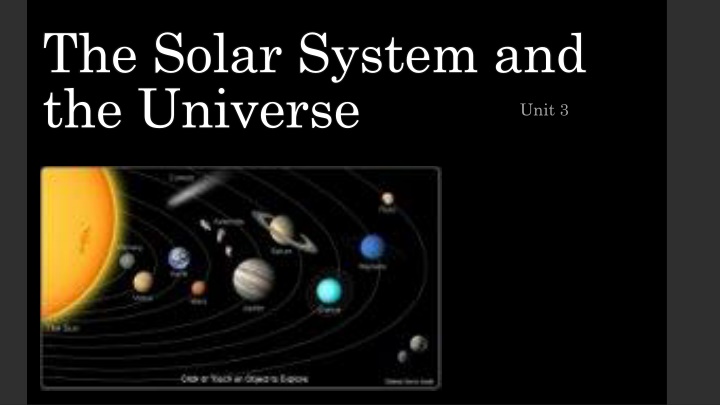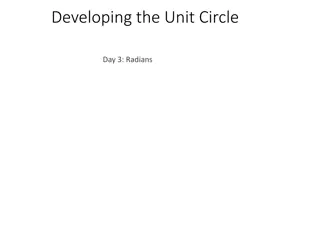
Exploring Galaxies, Stars, and Planets in the Universe
Delve into the vast expanse of the universe with a deep dive into galaxies, stars, and planets. Learn about the different types of galaxies, such as spiral, barred spiral, irregular, and elliptical, each with unique characteristics. Discover how stars form and their classification based on color, temperature, brightness, and size. Uncover the mysteries of planets, categorized as inner and outer planets, and what lies between them in our solar system. Join us on a cosmic journey of exploration and discovery.
Download Presentation

Please find below an Image/Link to download the presentation.
The content on the website is provided AS IS for your information and personal use only. It may not be sold, licensed, or shared on other websites without obtaining consent from the author. If you encounter any issues during the download, it is possible that the publisher has removed the file from their server.
You are allowed to download the files provided on this website for personal or commercial use, subject to the condition that they are used lawfully. All files are the property of their respective owners.
The content on the website is provided AS IS for your information and personal use only. It may not be sold, licensed, or shared on other websites without obtaining consent from the author.
E N D
Presentation Transcript
The Solar System and the Universe Unit 3
Question of the Day There are two types of spiral galaxies. What is the difference between a barred spiral galaxy and normal spiral galaxy? A. The number of spiral arms B. The shape of the galaxy's center C. The number of stars in the galaxy D. The color of the stars in the galaxy
Question of the Day Eliliptical galaxies are brightest toward the center. Which reasoning best explains this observation? A. The stars are evenly distributed through the galaxy. B. The center is crowded with stars decreases farther out. C. Most of the stars are near the outside of the elliptical galaxy with dust clouds in the center. D. The stars are spread throughout the galaxy in bands that look like arms of spiral galaxies
Galaxies & Stars Universe is everything that exists. A galaxy is a group of billons of stars, the objects that orbit the stars, gas and dust. Stars are huge balls of hot, glowing gases that produce their own heat and light Form when gravity causes gas and dust particles found in space pull and are squeezed together under great pressure. They also store energy that is released as heat and light. Classified by their color, temperature, brightness, and size Color tells us about the stars temperature: blue being the hottest; red being the coolest Size tells us about the stars brightness amount of visible light it gives off (The sun is a medium size yellow star)
Galaxies & Stars Types of galaxies: Spiral Galaxies consist of a rotating disk of young stars, gas, and dust and a central bulge made of older stars. Barred Spiral Galaxies may have 2 or more spiral arms. Unlike regular spirals, there are young stars at the center of barred spirals. Irregular Galaxies do not have any particular shape. The stars are randomly scattered. There is lots of gas and dust to form new stars. Elliptical Galaxies are brightest at the center. They can be shaped like a perfect sphere or a flattened globe. The center is crowded with stars.
Question of the Day Planets are classifies as either inner planets or outer planets based on their distance from the sun, What is found between the inner planets and the outer planets? A. Asteroids B. Comets C. Moons D. Stars
Question of the Day While looking at the sky one night, Bevan saw a streak of light. Bevan s father told him that the light was produced by a small chunk of rock passing through Earth s atmosphere. Which of these terms best describes what Bevan saw? A. Asteroids B. Comets C. Meteor D. Meteorite
Flying objects Dwarf Planets are nearly round bodies whose orbits cross the orbits of other bodies. Most are found pass Neptune's Orbit called the Kuiper Belt. Asteroids are rock and iron objects that orbit the sun. Found mainly between Mars and Jupiter known as the asteroid belt As small as a city block, as big as the ocean Can even have their own moon Meteoroids, Meteors, and Meterorites Pieces if rock that break off asteroids and travel through space When they burn up in the Earth's atmosphere they cause a streak of light called meteor. When they reach Earth's surface they are called meterorites. A comet is a chunk of frozen gas, rock, ice, and dust. Long orbits around the sun
Question of the Day Which of the following planets has a large solid core? A. Jupiter B. Mercury C. Neptune D. Saturn
Question of the Day Which of the following characteristics distinguishes the outer planets from the inner planets? A. The outer planets have many moons. B. The outer planets orbit in a different direction. C. The outer planets have higher densities. D. The outer planets have smaller diameters.
The Solar System A solar system is made up of a star and the planets and other space that revolve around it. Planet large, round body that revolves around a star that rotate on an axis Inner planets: Mercury, Venus, Earth, and Mars Closer to the sun Density, rocky, thin atmosphere, small diameters, few moons Large solid cores at their center Revolution times are short Outer Planets: Jupiter, Saturn, Uranus, and Neptune Farthest from the sun Known as gas giants Don't have solid surface and are colder, cores are very small, many moons Moons small natural objects that revolve around the other objects. Many planets have moons.
Planet Project PowerPoint needs to have 3-5 pictures Distance from the sun/ planet from the sun Length of time for one revolution (hours in a day) Length of rotation around the sun Diameter (size) Temperature Number of moons density Inner/outer Gas/solid core 2 3 fun facts






















